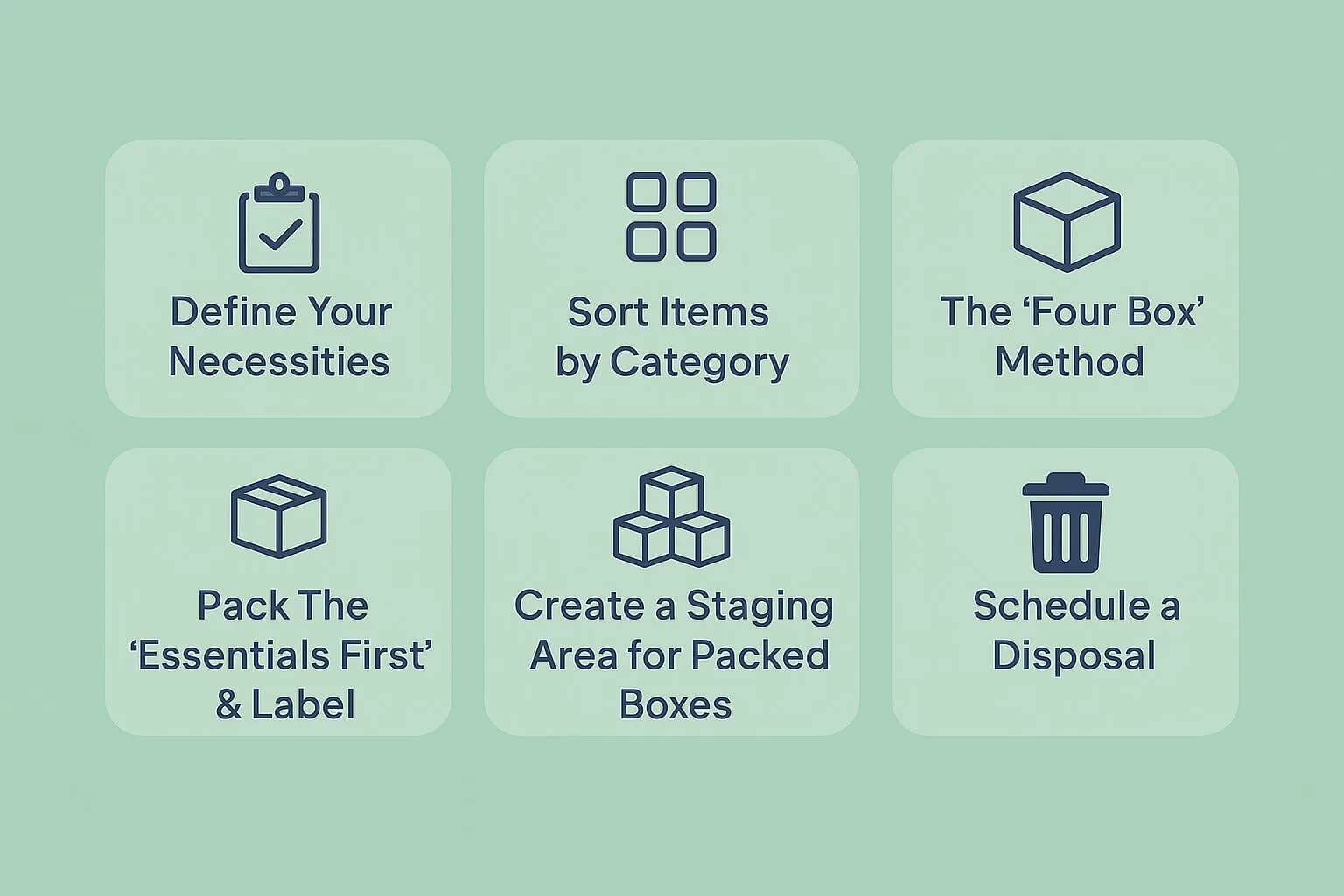14 October, 2025
How to Declutter Your Home Before Moving (Quick Steps)

"You’re not just moving houses, you’re moving forward. Let go of what no longer serves you."
Moving is the perfect opportunity to start fresh, not just in a new space, but in how you live. And the first step to a fresh start? Learning how to declutter your home before moving. There’s no benefit in carrying a bunch of unwanted stuff.
Many people struggle with decluttering when moving because it can feel overwhelming to decide what to keep or let go. But with a simple plan, you can make the process manageable and even freeing. This guide will help you take practical steps to lighten your load and prepare for a smoother move.
Declutter Your Home and Get Packed in 6 Simple Steps 🔗
Decluttering before a move doesn’t have to be a headache. It’s really about making space both physical and mental for your new chapter. With a clear plan and simple steps, you’ll find letting go easier than you thought. Here’s your steps-

Step 1: Define Your Necessities 🔗
Okay, before you start packing, take a moment to really think about what you actually need in your new home. Moving is a fresh start, so this is the perfect time to be honest with yourself. Ask yourself things like:
- Do I wear these clothes or use this item regularly?
- Will this fit comfortably in my new home?
- Does it bring me joy or have a real purpose?
Write down a simple list of essentials you want to keep. Also, think about the space you’ll have. Moving from a big house to a smaller apartment? That huge bookshelf might not fit, so it’s okay to let it go. Downsizing means making smart choices about what really fits your lifestyle and space, so you can live more comfortably.
Learn More: How to Prepare Your Home for Sale
Step 2: Sort Items by Category 🔗
Now that you know what essentials to keep, let’s make things easier by sorting everything by category. Instead of jumping from one random pile to another, gather similar items together. For example, collect all your clothes from different closets into one spot, or bring all your books into one corner.
Seeing everything from one category at once helps you get a clear picture of how much you actually have. Sometimes, it’s surprising how many pairs of shoes or mugs you own! When things are grouped, it’s easier to decide what you really want to keep and what you can let go of.
Plus, sorting by category makes packing way simpler later on. You'll already know where everything goes. Trust me, it saves a lot of time and stress!
Step 3: The ‘Four Box’ Method 🔗
The Four Box Method is a popular and practical decluttering technique widely recommended by professional organizers and featured in many home organization guides. Grab four boxes or bins and label them Keep, Donate, Recycle, and Trash. As you go through your stuff, make a quick decision about where each item belongs.
- Put things you love and will use in the Keep box.
- Stuff that’s in good shape but you no longer need? That goes into Donate
- Paper, plastics, or electronics that can be recycled go into the Recycle box.
- And finally, anything broken, worn out, or unusable goes in the Trash.
This method helps you stay organized and make decisions quickly without getting stuck.
Step 4: Pack The "Essentials First" & Label 🔗
Start packing the things you’ll need right away in your new home. This could be your favorite clothes, toiletries, phone chargers, important documents, and some basic kitchen items.
Use small boxes or bags for these essentials and label them clearly with “OPEN FIRST” or “ESSENTIALS.” This way, on moving day, you can quickly find what you need without digging through all the boxes.This also gives you a clear view of your remaining space, which can help you figure out what to do with unwanted stuff when moving.
Step 5: Create a Staging Area for Packed Boxes 🔗
Pick one spot in your home where all packed boxes will live until moving day. It could be a corner in the living room, the garage, a spare bedroom, or even an area cleared during a basement cleanout. Having a designated staging area keeps your home tidy and makes loading the moving truck much easier.
Step 6: Schedule a Disposal 🔗
After sorting out your Donate, Recycle, and Trash boxes, make sure to arrange for their proper disposal. Booking a reliable junk removal service can make this process stress-free. When deciding between dumpster rental and junk removal, consider the size and type of items you need to dispose of to choose the best option. You also have other choices: you can donate gently used items to local charities or thrift stores, many of which offer free pickup for large donations. For recyclable materials like paper, plastics, and electronics, take them to your nearest recycling center or attend special e-waste collection events.
How to Get Rid of Everything and Move 🔗
Now, this is the scenario where, let’s say, you are moving abroad and letting go of everything. I will add three additional tips here.
1. Create a “Must-Have” List 🔗
Before packing, write down the absolute essentials you’ll need abroad like important documents, medications, a few clothing items, and personal valuables.
2. Sort by Usefulness and Space 🔗
Review your belongings category by category and prioritize lightweight, multipurpose, and essential items that fit your luggage or shipping limits. For everything else, decide if donating, selling, or recycling is the best option.
3. Digitize Sentimental Items 🔗
To avoid lugging bulky keepsakes, scan photos, letters, and important papers. Digital copies preserve your memories without the physical clutter, making your move lighter and easier.
Checklist: Things to Buy Before Decluttering 🔗
- Sturdy Boxes — Various sizes for sorting and packing
- Heavy-Duty Trash Bags — For broken or unwanted items
- Labels and Markers — To clearly mark boxes and bags
- Packing Tape — Strong tape to seal boxes securely
- Reusable Storage Bins — Great for items you want to keep organized
- Gloves — To protect your hands while sorting and handling junk
- Cleaning Supplies — For wiping down surfaces as you declutter
- Drawer Organizers or Small Containers — For small items like jewelry or office supplies
- Donation Bags or Boxes — Dedicated containers for items to give away
- A Notebook or Planner — To jot down what to keep, toss, or donate
Common Mistakes People Make When Decluttering Before a Move 🔗

Many people make avoidable mistakes that make the process harder than it needs to be. Here, we’ll cover the most common missteps.
Starting Too Late 🔗
Many wait until the last minute to start decluttering. This causes stress and rushed decisions. You end up keeping stuff you don’t really need. To avoid this, start early. Ideally, begin 2 to 3 months before moving day. If you have a lot to sort, start even earlier. Break the job into small daily or weekly tasks. This makes it easier and less overwhelming.
Not Having a Clear Plan for Discarded Items 🔗
Some people make piles of things to donate, sell, or throw away but then those piles just stay around. This just creates more clutter! Before you start, decide how you will get rid of these items. Schedule donation pickups or look up recycling centers nearby. Plan a yard sale if you want. Get rid of things as soon as boxes or bags fill up. Don’t let clutter sit.
Holding Onto Things "Just in Case" 🔗
It’s normal to feel unsure about letting go. But holding on to things “just in case” means moving stuff you probably won’t use. If you haven’t used something in 6 to 12 months (except seasonal items), think about letting it go. Ask yourself, “Can I replace this easily if I need it later?” This helps keep your move lighter and simpler.
Getting Bogged Down by Sentimental Items 🔗
Starting with sentimental things like photos and keepsakes can be tough. You might get stuck remembering old times and lose focus. It’s better to save these items for last. First, clear out easier stuff like old clothes, expired food, or broken things. When you’re ready, set a timer to avoid getting overwhelmed. You can also scan photos to save space but still keep memories.
Not Labeling Boxes Clearly 🔗
This one isn’t about decluttering, but it’s very important. Poor or missing labels on boxes make unpacking frustrating. Label every box clearly on two sides. Write the room it goes to (like “Kitchen” or “Bedroom 2”). Add a short list of what’s inside (“Pots & Pans” or “Books”). Mark boxes “FRAGILE” if needed. Clear labels save you time and hassle later.
End Note 🔗
So, are you ready to declutter your home before moving? Keep these quick tips in mind: start early, tackle the task in small chunks, be honest about what you really need, and say goodbye to that “just in case” stuff. And don’t forget to label your boxes clearly and have a plan to get rid of unwanted items. You’ve got this!
Frequently Asked Questions 🔗
Why should I declutter before moving? 🔗
Decluttering before a move helps reduce the number of items you need to pack, saving you time, money, and energy. It also allows you to start fresh in your new home with only the things you truly need and love.
When should I start decluttering before a move? 🔗
Start at least 4–6 weeks before your move date. This gives you enough time to sort through each room carefully, decide what to keep, and arrange donations, sales, or junk removal without feeling rushed.
What is the best way to declutter before moving? 🔗
The best approach is to work room by room and create four piles: keep, donate, sell, and toss. Pack only the items you truly need or value, and deal with unwanted things immediately so they don’t pile back up.
How do I decide what to keep or throw away? 🔗
Ask yourself if you’ve used the item in the past year and whether it still serves a purpose or brings you joy. If the answer is no, it’s best to donate, sell, or recycle it before moving.
Where can I donate unwanted items before moving? 🔗
ou can donate to local charities, Goodwill, Habitat for Humanity, or shelters. Many organizations offer free pickup services for furniture and large household items, making the process even easier.
Can decluttering make moving cheaper? 🔗
Absolutely. Moving companies often charge based on weight or volume, so fewer items mean a smaller truck, less packing material, and lower labor costs — ultimately saving you money.
Share on
Sabbir Kabir is a content manager at WeCycle with over 5 years of experience in creating content about junk removal services, eco-friendly waste disposal, and sustainable recycling practices. Passionate about promoting environmental responsibility, Sabbir shares actionable insights to help homeowners and businesses adopt greener, cleaner waste management solutions.
